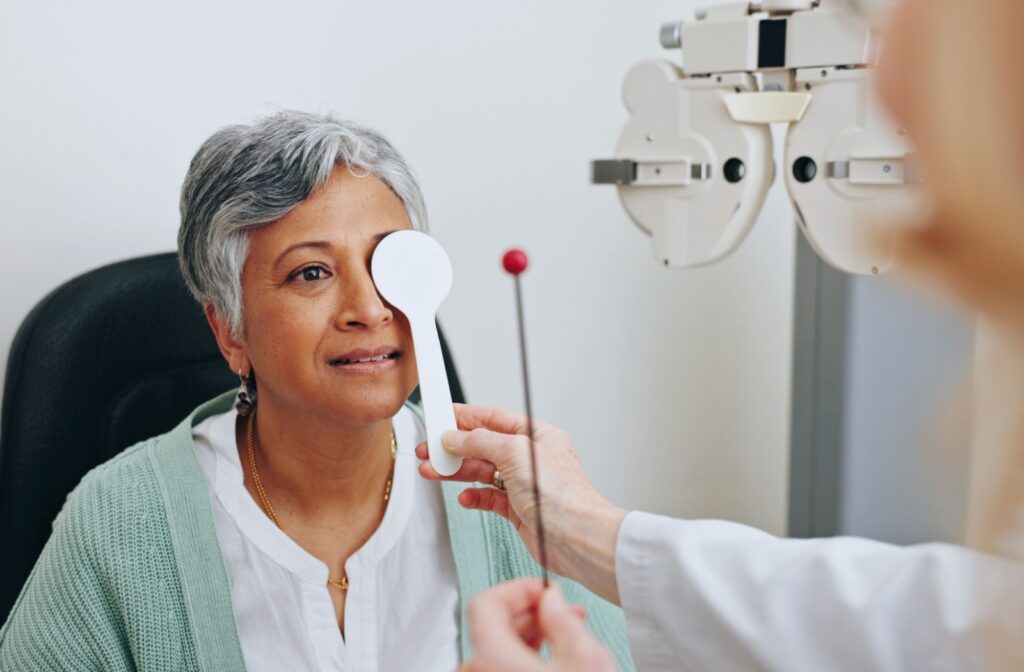Constant headaches that don’t seem to go away, unexplainable nausea, or even difficulty focusing on words while reading might seem like unrelated symptoms. But one root cause, Binocular Vision Dysfunction (BVD), can produce them all.
BVD essentially means your eyes aren’t working together as they should, making your brain work harder to process visual information, and leaving you uncomfortable. BVD can develop from several causes, the most common being:
- Congenital eye misalignment
- Weak or aging eye muscles
- Head injuries or trauma
Once you have an accurate diagnosis, treating BVD is possible with prism lenses or Neurolens, along with vision therapy. Your eye doctor can determine the right treatment plan.
What Is Binocular Vision Dysfunction?
Binocular Vision Dysfunction (BVD) is a condition that occurs when your eyes struggle to work together as a team. Normally, both eyes align perfectly and send the brain two nearly identical images, which the brain seamlessly processes into one cohesive picture.
However, with BVD, subtle misalignments in how the eyes work together can cause the brain to overcompensate, leading to significant physical strain over time.
BVD is not just an annoyance; it can seriously affect your day-to-day quality of life. Some people might “feel off” or “unbalanced,” and its effects can range from mild to severe. It can also masquerade as other conditions (think motion sickness), making it all the more challenging to identify without a proper diagnosis.
A Synchronized Team: The Eyes & Brain
Your eyes are your brain’s main visual input system. They collect information about the world around you and deliver it to your brain, which processes this input to capture exactly what you see.
Here’s where the teamwork comes in. Each of your eyes has a slightly different view of the world. Your brain uses a process called “fusion” to merge the differing inputs from your eyes. This process is essential for depth perception, reading, focusing, and tracking visuals.
Your eyes, however, must be in proper alignment for this process to work smoothly. When they’re not in alignment, the system falters. The images from each eye don’t match up well enough for the brain to fuse them comfortably, which forces it to work overtime to compensate.
This ongoing strain may result in the symptoms commonly associated with BVD.
The Symptoms of BVD
The tricky thing with BVD is how subtle misalignment can be. Symptoms of BVD often overlap with other health issues.
Common signs of BVD include:
- Double or blurry vision
- Frequent headaches or migraines
- Dizziness or feeling off-balance
- Difficulty concentrating
- Nausea and motion sickness
- Trouble with depth perception
- Eye strain or fatigue, especially after long periods of reading or screen use
BVD can develop at any stage of life, but certain triggers, such as childhood learning struggles, head trauma, or aging muscles, may increase the likelihood of symptoms.
What Causes BVD?
BVD can develop from a range of factors. Three of the most common causes include:
Congenital Eye Misalignment
Some people are born with minor eye misalignment, known as congenital eye misalignment.
Even if the eyes look “straight” to the naked eye, a small asymmetry can disrupt signaling between the eyes and the brain.
Children with undiagnosed BVD may encounter challenges in the classroom, such as reading difficulties or shorter attention spans. Parents and teachers often mistake these struggles for learning disabilities when, in fact, they may stem from an underlying vision issue. This underscores the importance of annual routine eye exams.
Weak or Aging Eye Muscles
Over time or with significant use, the eye muscles may weaken or lose coordination. Aging adults who sit in front of screens or strain their eyes for long periods may start experiencing symptoms they’ve never felt before.
While small misalignments might be manageable early in life, aging can magnify these issues, making previously minor symptoms more noticeable and hard to ignore.
Head Injuries or Trauma
Trauma, such as concussions or whiplash, can significantly disrupt the delicate alignment of your eyes. These injuries are increasingly recognized for their role in triggering BVD, particularly if symptoms like dizziness and headaches persist long after the trauma event.
For example, post-concussion syndrome is an area where binocular vision challenges often arise, but can be overlooked during standard checkups.

Can You Treat Binocular Vision Dysfunction?
The good news is that BVD is treatable.
However, BVD’s subtle nature can be tricky to diagnose without your eye doctor’s support. Conditions such as migraines, ADHD, anxiety, or even inner-ear issues, such as vertigo, can mimic BVD, which is why an accurate diagnosis is vital for treatment.
The Diagnosis
If you’re experiencing common symptoms of BVD, it’s worth mentioning to your eye doctor. We can take a closer look.
This involves a series of specialty tests and tools that measure how your eyes align and track objects, separate from a routine eye exam’s standard screening.
Treatment Options
Prism eyeglasses are the go-to solution for treating BVD. These eyeglass lenses help realign how light enters the eyes, reducing the strain on the brain and nerves, while also correcting your vision.
Neurolens goes a step further.
Neurlens is custom-made to correct eye misalignment, thereby directly addressing BVD. The Neurolens Measurement Device identifies the exact prism correction required for each patient to reduce eye strain, helping to improve focus, reduce fatigue, and minimize associated symptoms like headaches and dizziness.
Pairing prism or Neurolens eyewear with vision therapy can help retrain the brain and eyes to work together smoothly over time.
Empower Your Vision
Your body is a complex but precise system. Even slight misalignment can leave you feeling off and uncomfortable. Fortunately, when it comes to Binocular Vision Dysfunction, an accurate diagnosis and treatment can make a noticeable difference in your vision and overall comfort.
If you’ve been battling unexplained headaches or struggling to focus while reading, it might be time to explore whether BVD could be the root cause. Connect with our Total Vision Pasadena team to book an appointment and restore comfort and clarity in your life.




